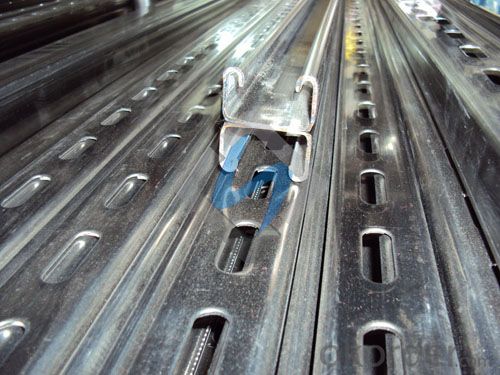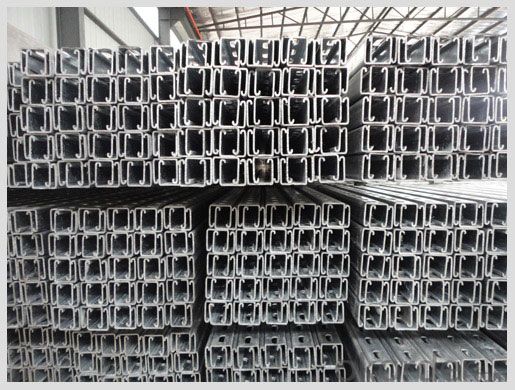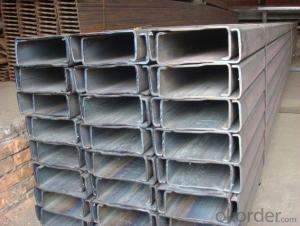20MM-250MM stainless steel angle for construction
- Loading Port:
- Tianjin
- Payment Terms:
- TT OR LC
- Min Order Qty:
- 10000 m.t.
- Supply Capability:
- 2000000 m.t./month
OKorder Service Pledge
OKorder Financial Service
You Might Also Like
Item specifice
Product Description:
OKorder is offering 20MM-250MM stainless steel angle for construction at great prices with worldwide shipping. Our supplier is a world-class manufacturer of steel, with our products utilized the world over. OKorder annually supplies products to European, North American and Asian markets. We provide quotations within 24 hours of receiving an inquiry and guarantee competitive prices.
Product Applications:
20MM-250MM stainless steel angle are ideal for structural applications and are widely used in the construction of buildings and bridges, and the manufacturing, petrochemical, and transportation industries.
Product Advantages:
OKorder's Steel angle are durable, strong, and resist corrosion.
Main Product Features:
· Premium quality
· Prompt delivery & seaworthy packing (30 days after receiving deposit)
· Corrosion resistance
· Can be recycled and reused
· Mill test certification
· Professional Service
· Competitive pricing
Product Specifications:



FAQ:
Q1: Why buy Materials & Equipment from OKorder.com?
A1: All products offered byOKorder.com are carefully selected from China's most reliable manufacturing enterprises. Through its ISO certifications, OKorder.com adheres to the highest standards and a commitment to supply chain safety and customer satisfaction.
Q2: What makes stainless steel stainless?
A2: Stainless steel must contain at least 10.5 % chromium. It is this element that reacts with the oxygen in the air to form a complex chrome-oxide surface layer that is invisible but strong enough to prevent further oxygen from "staining" (rusting) the surface. Higher levels of chromium and the addition of other alloying elements such as nickel and molybdenum enhance this surface layer and improve the corrosion resistance of the stainless material.
- Q:Can steel angles be galvanized or coated for additional protection?
- Yes, steel angles can indeed be galvanized or coated for additional protection. Galvanizing is a common method used to protect steel from corrosion. It involves coating the steel with a layer of zinc, which acts as a barrier against moisture and other corrosive elements. This process can be done through hot-dip galvanizing, where the steel angle is immersed in a bath of molten zinc, or through electroplating, where a thin layer of zinc is applied to the surface of the steel through an electric current. Coating steel angles with other protective materials is also a viable option. There are various coating options available, such as epoxy, powder coatings, and paint. These coatings create a protective layer on the surface of the steel, shielding it from environmental factors that could lead to corrosion or damage. By galvanizing or coating steel angles, additional protection is provided, extending the lifespan of the material and ensuring its durability in different applications and environments.
- Q:What are the different types of steel angles connections for roof trusses?
- There are several types of steel angle connections commonly used for roof trusses, including gusset plate connections, bolted connections, welded connections, and clip angle connections. These connections are designed to provide stability and strength to the truss system, ensuring the overall integrity and safety of the roof structure.
- Q:What are the different types of steel angle connections used in seismic design?
- There are several types of steel angle connections commonly used in seismic design, including bolted angle connections, welded angle connections, and moment-resisting angle connections. Bolted angle connections involve connecting angles together using bolts, providing flexibility and ease of installation. Welded angle connections involve welding the angles together, creating a strong and rigid connection. Moment-resisting angle connections are designed to resist bending moments and provide enhanced resistance against seismic forces. These connections typically combine elements of both bolted and welded connections to achieve optimal strength and flexibility.
- Q:What are the different types of steel angles used in storage systems?
- There are several different types of steel angles that are commonly used in storage systems. These angles play a crucial role in providing structural support and stability to the storage racks. Here are some of the most commonly used steel angles in storage systems: 1. Equal angle: This type of angle has equal sides and is commonly used in storage systems to create sturdy frames and supports. Equal angles are often used for the uprights and beams in pallet racking systems. 2. Unequal angle: As the name suggests, unequal angles have sides of different lengths. They are often used in storage systems to accommodate specific design requirements where different load capacities or dimensions are needed. 3. Slotted angle: Slotted angles have holes along their length, allowing for easy adjustability and flexibility in storage system design. These angles are popular in DIY storage projects and can be easily cut and bolted together to create customized storage solutions. 4. L-shaped angle: L-shaped angles, also known as corner angles or corner brackets, are used to reinforce the corners of storage racks and provide extra strength and stability. They are typically used in combination with other angles to create sturdy connections. 5. Rolled steel angle: Rolled steel angles are produced by rolling a flat steel strip into an L-shaped angle. They are commonly used in storage systems where high load-bearing capacity and durability are required. Rolled steel angles are often used in heavy-duty industrial storage applications. These are just a few examples of the different types of steel angles used in storage systems. The specific type of angle used will depend on factors such as the load capacity, design requirements, and the specific needs of the storage system.
- Q:Can steel angles be used in bridges or elevated walkways?
- Bridges and elevated walkways can indeed utilize steel angles. Construction projects often employ steel angles because of their strength and versatility. These angles offer structural support and stability, making them perfect for applications like bridges and elevated walkways. By utilizing steel angles, one can establish a framework and support system that guarantees durability and safety for these structures. Furthermore, the ease of welding or bolting steel angles together enables efficient installation and maintenance. In conclusion, the construction of bridges and elevated walkways frequently leans towards steel angles due to their strength, dependability, and user-friendly nature.
- Q:Can steel angles be used for storage racks?
- Yes, steel angles can be used for storage racks. Steel angles are commonly used in the construction industry for their strength and durability. They can easily be shaped into various configurations, including the design of storage racks. The angles provide structural support and stability, making them ideal for storing heavy items. Additionally, steel angles are resistant to corrosion, which is important for maintaining the integrity of the storage racks over time. Overall, steel angles are a reliable and commonly used material for constructing storage racks.
- Q:What are the different types of corrosion protection coatings for steel angles?
- For steel angles, there exists a variety of corrosion protection coatings that serve different purposes in safeguarding against corrosion. 1. Paint Coatings: Paint coatings are frequently employed for corrosion protection of steel angles. Acting as a barrier, they shield the steel surface from corrosive elements present in the surroundings. These coatings are typically applied in multiple layers and can be tailored to meet specific needs, such as resistance to chemicals or UV radiation. 2. Galvanizing: Another extensively used method for corrosion protection in steel angles is galvanizing. This process entails the application of a zinc layer to the steel surface through hot-dip galvanizing. By acting as a sacrificial anode, this coating provides excellent corrosion protection, sacrificing itself before the steel. Galvanized steel angles are commonly utilized in outdoor settings where exposure to moisture and harsh weather conditions is expected. 3. Powder Coatings: Powder coatings, which are applied as a dry powder and cured with heat, offer a durable and corrosion-resistant finish for steel angles. These coatings can be customized in terms of color, texture, and thickness, ensuring both aesthetic appeal and enhanced protection against corrosion. 4. Epoxy Coatings: Industrial applications often require the use of epoxy coatings when steel angles may be exposed to harsh chemicals or abrasive environments. These coatings form a robust and protective layer that resists corrosion, chemicals, solvents, and abrasion. They can be applied as a single layer or combined with other coatings for added protection. 5. Organic Coatings: In architectural applications where corrosion protection is necessary while maintaining an attractive appearance, organic coatings such as polyurethane or acrylic coatings are commonly used for steel angles. These coatings offer good resistance to weathering, UV radiation, and corrosion, ensuring the longevity of the steel angles. When selecting a corrosion protection coating for steel angles, it is crucial to consider the specific application, environmental conditions, and budget constraints. Seeking advice from corrosion specialists or coating suppliers can help determine the most suitable coating for the intended use.
- Q:Are steel angles corrosion resistant?
- Steel angles, unless specially designed and treated, are generally prone to corrosion. They are typically made from carbon steel, which can corrode when exposed to moisture, oxygen, and other corrosive substances. Nevertheless, stainless steel angles, enhanced with chromium and other alloying elements, offer greater resistance to corrosion. These stainless steel angles are commonly employed in corrosive environments like marine or industrial settings. To evaluate the corrosion resistance of a steel angle, one must carefully consider its specific type and grade.
- Q:Are there any environmental concerns associated with steel angles?
- Yes, there are environmental concerns associated with steel angles. The production of steel angles involves the extraction of iron ore, which can have significant impacts on ecosystems, including habitat destruction and water pollution. Additionally, the manufacturing process of steel angles requires high energy consumption, contributing to greenhouse gas emissions and climate change. To mitigate these concerns, sustainable practices such as using recycled steel and improving energy efficiency in production can be implemented.
- Q:Can steel angles be used in storage rack systems?
- Yes, steel angles can be used in storage rack systems. Steel angles are commonly used in the construction industry and have a variety of applications, including storage racks. They provide structural support and stability to the rack system, making them suitable for storing heavy items. Steel angles are strong, durable, and resistant to bending or warping under heavy loads, making them ideal for supporting shelves and organizing materials in storage racks. Additionally, steel angles can be easily welded or bolted together, allowing for easy customization and flexibility in designing storage rack systems. Overall, steel angles are a reliable and cost-effective option for building storage rack systems.
1. Manufacturer Overview |
|
|---|---|
| Location | |
| Year Established | |
| Annual Output Value | |
| Main Markets | |
| Company Certifications | |
2. Manufacturer Certificates |
|
|---|---|
| a) Certification Name | |
| Range | |
| Reference | |
| Validity Period | |
3. Manufacturer Capability |
|
|---|---|
| a)Trade Capacity | |
| Nearest Port | |
| Export Percentage | |
| No.of Employees in Trade Department | |
| Language Spoken: | |
| b)Factory Information | |
| Factory Size: | |
| No. of Production Lines | |
| Contract Manufacturing | |
| Product Price Range | |
Send your message to us
20MM-250MM stainless steel angle for construction
- Loading Port:
- Tianjin
- Payment Terms:
- TT OR LC
- Min Order Qty:
- 10000 m.t.
- Supply Capability:
- 2000000 m.t./month
OKorder Service Pledge
OKorder Financial Service
Similar products
New products
Hot products
Related keywords


























